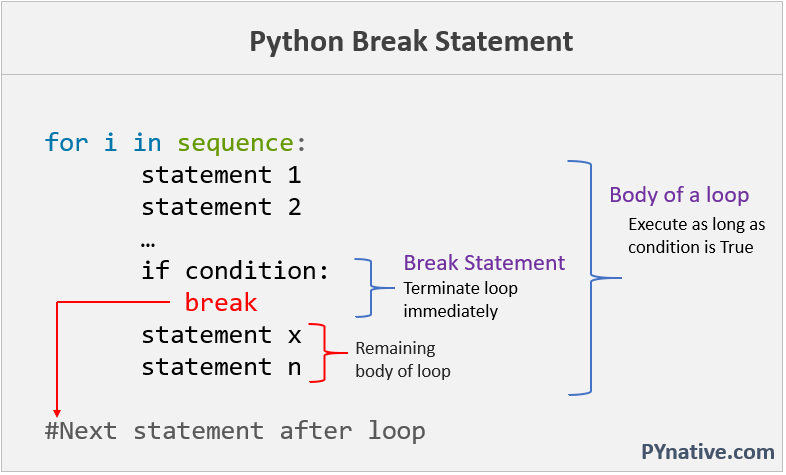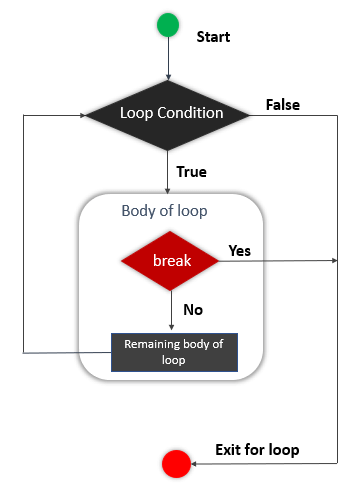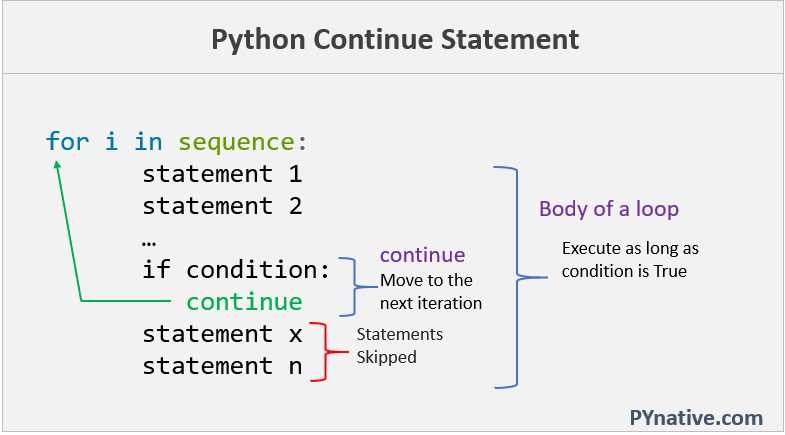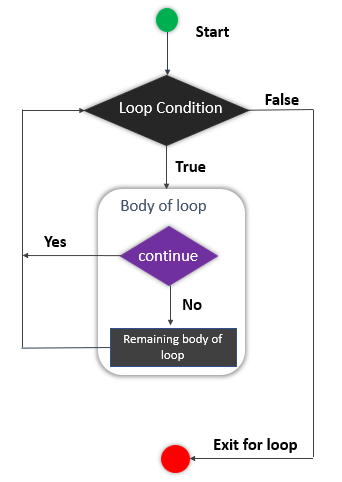In this article, you will learn how to use the break, continue and pass statements when working with loops in Python. We use break, continue statements to alter the loop’s execution in a certain manner.
| Statement | Description |
|---|---|
break | Terminate the current loop. Use the break statement to come out of the loop instantly. |
continue | Skip the current iteration of a loop and move to the next iteration |
pass | Do nothing. Ignore the condition in which it occurred and proceed to run the program as usual |
The break and continue statements are part of a control flow statements that helps you to understand the basics of Python.
Break Statement in Python
The break statement is used inside the loop to exit out of the loop. In Python, when a break statement is encountered inside a loop, the loop is immediately terminated, and the program control transfer to the next statement following the loop.
In simple words, A break keyword terminates the loop containing it. If the break statement is used inside a nested loop (loop inside another loop), it will terminate the innermost loop.
For example, you are searching a specific email inside a file. You started reading a file line by line using a loop. When you found an email, you can stop the loop using the break statement.
We can use Python break statement in both for loop and while loop. It is helpful to terminate the loop as soon as the condition is fulfilled instead of doing the remaining iterations. It reduces execution time.
Syntax of break:
breakCode language: Python (python)
Let us see the usage of the break statement with an example.
Example: Break for loop in Python
In this example, we will iterate numbers from a list using a for loop, and if we found a number greater than 100, we will break the loop.
Use the if condition to terminate the loop. If the condition evaluates to true, then the loop will terminate. Else loop will continue to work until the main loop condition is true.
Output:
curret number 10 curret number 40
Note: As you can see in the output, we got numbers less than 100 because we used the break statement inside the if condition (the number is greater than 100) to terminate the loop
How break statement works
We used a break statement along with if statement. Whenever a specific condition occurs and a break statement is encountered inside a loop, the loop is immediately terminated, and the program control transfer to the next statement following the loop.
Let’s understand the above example iteration by iteration.
- In the first iteration of the loop, 10 gets printed, and the condition
i > 100is checked. Since the value of variableiis 10, the condition becomes false. - In the second iteration of the loop, 20 gets printed again, and the condition
i > 100is checked. Since the value ofiis 40, the condition becomes false. - In the third iteration of the loop, the condition
i > 100becomes true, and thebreakstatement terminates the loop
Example: Break while loop
We can use the break statement inside a while loop using the same approach.
Write a while loop to display each character from a string and if a character is a space then terminate the loop.
Use the if condition to stop the while loop. If the current character is space then the condition evaluates to true, then the break statement will execute and the loop will terminate. Else loop will continue to work until the main loop condition is true.

Break Nested Loop in Python
To terminate the nested loop, use a break statement inside the inner loop. Let’s see the example.
In the following example, we have two loops, the outer loop, and the inner loop. The outer for loop iterates the first 10 numbers using the range() function, and the internal loop prints the multiplication table of each number.
But if the current number of both the outer loop and the inner loop is greater than 5 then terminate the inner loop using the break statement.
Example: Break nested loop
Break Outer loop in Python
To terminate the outside loop, use a break statement inside the outer loop. Let’s see the example.
In the following example, we have two loops, the outer loop, and the inner loop. The outer loop iterates the first 10 numbers, and the internal loop prints the multiplication table of each number.
But if the current number of the outer loop is greater than 5 then terminate the outer loop using the break statement.
Example: Break outer loop
Continue Statement in Python
The continue statement skip the current iteration and move to the next iteration. In Python, when the continue statement is encountered inside the loop, it skips all the statements below it and immediately jumps to the next iteration.
In simple words, the continue statement is used inside loops. Whenever the continue statement is encountered inside a loop, control directly jumps to the start of the loop for the next iteration, skipping the rest of the code present inside the loop’s body for the current iteration.
In some situations, it is helpful to skip executing some statement inside a loop’s body if a particular condition occurs and directly move to the next iteration.
Syntax of continue:
continueCode language: Python (python)Let us see the use of the continue statement with an example.

Example: continue statement in for loop
In this example, we will iterate numbers from a list using a for loop and calculate its square. If we found a number greater than 10, we will not calculate its square and directly jump to the next number.
Use the if condition with the continue statement. If the condition evaluates to true, then the loop will move to the next iteration.
Output:
Current Number is 2
Square of a current number is 4
Current Number is 3
Square of a current number is 9
Current Number is 11
Current Number is 7
Square of a current number is 49Code language: Python (python)Note: As you can see in the output, we got square of 2, 3, and 7, but the loop ignored number 11 because we used the if condition to check if the number is greater than ten, and the condition evaluated to true, then loop skipped calculating the square of 11 and moved to the next number.
How continue statement works
We used the continue statement along with the if statement. Whenever a specific condition occurs and the continue statement is encountered inside a loop, the loop immediately skips the remeaning body and move to the next iteration.

Let’s understand the above example iteration by iteration.
- In the first iteration of the loop, 4 gets printed, and the condition
i > 10is checked. Since the value ofiis 2, the condition becomes false. - In the second iteration of the loop, 9 gets printed, and the condition
i > 10is checked. Since the value ofiis 9, the condition becomes false. - In the third iteration of the loop, the condition
i > 10becomes true, and thecontinuestatement skips the remaining statements and moves to the next iteration of the loop - In the second iteration of the loop, 49 gets printed, and the condition
i > 10is checked. Since the value ofiis 7, the condition becomes false.
Example: continue statement in while loop
We can also use the continue statement inside a while loop. Let’s understand this with an example.
Write a while loop to display each character from a string and if a character is a space, then don’t display it and move to the next character.
Use the if condition with the continue statement to jump to the next iteration. If the current character is space, then the condition evaluates to true, then the continue statement will execute, and the loop will move to the next iteration by skipping the remeaning body.
Output:
J e s a a
Continue Statement in Nested Loop
To skip the current iteration of the nested loop, use the continue statement inside the body of the inner loop. Let’s see the example.
In the following example, we have the outer loop and the inner loop. The outer loop iterates the first 10 numbers, and the internal loop prints the multiplication table of each number.
But if the current number of the inner loop is equal to 5, then skip the current iteration and move to the next iteration of the inner loop using the continue statement.
Example: continue statement in nested loop
Continue Statement in Outer loop
To skip the current iteration of an outside loop, use the continue statement inside the outer loop. Let’s see the example
In the following example, The outer loop iterates the first 10 numbers, and the internal loop prints the multiplication table of each number.
But if the current number of the outer loop is even, then skip the current iteration of the outer loop and move to the next iteration.
Note: If we skip the current iteration of an outer loop, the inner loop will not be executed for that iteration because the inner loop is part of the body of an outer loop.
Example: continue statement in outer loop
Pass Statement in Python
The pass is the keyword In Python, which won’t do anything. Sometimes there is a situation in programming where we need to define a syntactically empty block. We can define that block with the pass keyword.
A pass statement is a Python null statement. When the interpreter finds a pass statement in the program, it returns no operation. Nothing happens when the pass statement is executed.
It is useful in a situation where we are implementing new methods or also in exception handling. It plays a role like a placeholder.
Syntax of pass statement:
for element in sequence:
if condition:
passCode language: Python (python)Example
Output
['January', 'June', 'March', 'April']
